In today’s diverse society, ensuring accessibility in places of worship is paramount. Churches, as centers of community and faith, strive to be inclusive spaces where all members of the congregation can participate fully in religious activities.
However, many churches face challenges in making their facilities accessible to individuals with mobility impairments. One significant barrier is the lack of elevators, which can hinder access to upper floors or sanctuary areas for those with disabilities or limited mobility.
To address this issue, grants for elevators in churches play a crucial role in providing financial assistance for the installation of elevators or other accessibility enhancements.
These grants aim to support churches in their efforts to remove physical barriers and create welcoming environments where everyone can worship and participate in religious services without hindrance.
By securing funding through grants, churches can embark on projects to install elevators, making their facilities more accessible and inclusive for all members of the community.
In this article, we will explore the various aspects of grants for elevators in churches, including eligibility criteria, application processes, and types of grants available, to assist churches in navigating this important funding opportunity.
What are Grants for Elevators in Churches
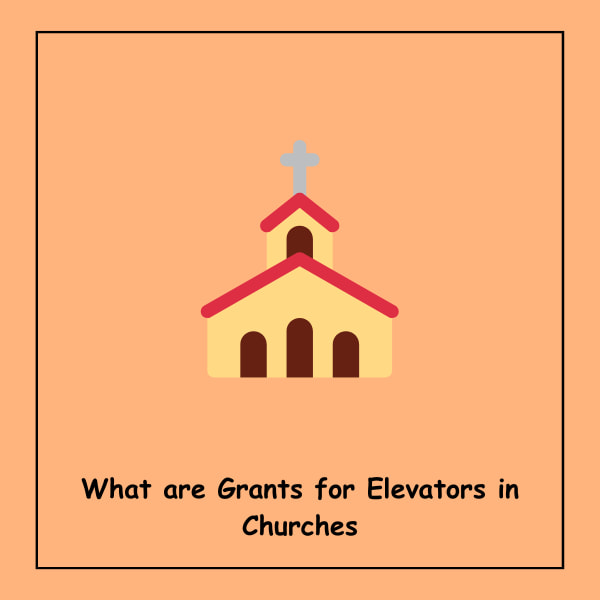
Grants for elevators in churches are financial assistance programs designed to alleviate the financial burden associated with installing elevators or enhancing accessibility features within church buildings.
These grants serve a critical purpose in addressing the challenges faced by individuals with mobility impairments when accessing different areas of a church, such as upper floors, fellowship halls, or sanctuary spaces.
By providing funding for elevator installation projects, these grants enable churches to create more inclusive environments where all members of the congregation can fully participate in religious services, events, and activities.
Beyond simply installing elevators, grants for elevators in churches may also cover the costs associated with retrofitting existing structures to comply with accessibility standards, such as widening doorways, installing ramps, or adding accessible restrooms.
Additionally, some grants may support the purchase of assistive technologies or equipment, such as stairlifts or platform lifts, to improve accessibility within the church building.
These grants are typically offered by government agencies, nonprofit organizations, foundations, or religious institutions with a commitment to promoting accessibility and inclusivity.
They may have specific eligibility criteria, application procedures, and funding requirements that churches must adhere to when seeking financial support for elevator projects.
Churches may need to demonstrate their nonprofit status, outline the need for elevator installation, provide detailed project proposals, and submit cost estimates to qualify for these grants.
Overall, grants for elevators in churches play a vital role in ensuring that places of worship are welcoming and accessible spaces for all individuals, regardless of physical abilities.
By investing in elevator installation projects, churches not only improve accessibility within their facilities but also demonstrate their commitment to inclusivity and serving the diverse needs of their congregation and community.
How to get Grants for Elevators in Churches
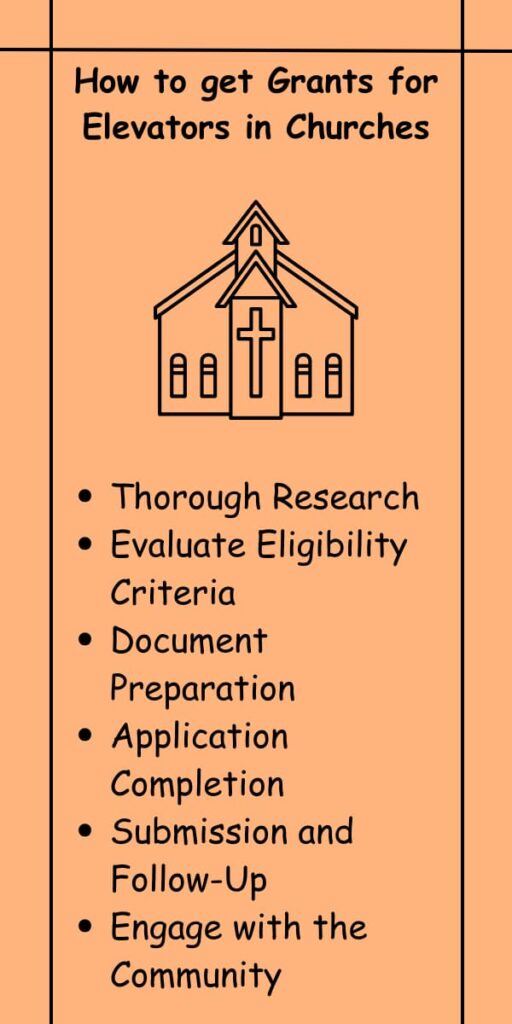
To obtain grants for elevators in churches, churches must follow specific steps and adhere to certain guidelines. Here’s a breakdown of how to navigate the process:
- Thorough Research: Start by conducting comprehensive research to identify various funding opportunities available for elevator installation projects in churches. Explore government agencies, nonprofit organizations, private foundations, and religious institutions that offer grants specifically tailored to support accessibility initiatives in places of worship.
- Evaluate Eligibility Criteria: Take the time to carefully review the eligibility criteria outlined by each grant provider. This may involve ensuring that the church holds nonprofit status, demonstrating a genuine commitment to enhancing accessibility within the facility, and aligning the proposed elevator project with the objectives of the grant program.
- Document Preparation: Gather all necessary documentation required for the grant application process. This typically includes proof of the church’s nonprofit status, detailed project proposals outlining the need for an elevator, architectural plans or assessments, itemized cost estimates for the project, and any additional supporting materials requested by the grant provider.
- Application Completion: Dedicate attention to completing the grant application accurately and comprehensively. Provide thorough explanations regarding the necessity of the elevator, its anticipated impact on accessibility for congregation members and visitors, and how the grant funds will be utilized to support the project. Adhere to any specific formatting guidelines or instructions stipulated by the grant provider to ensure the application meets all requirements.
- Submission and Follow-Up: Once the application is finalized, submit it within the specified timeframe, ensuring that all required documents are included. After submission, maintain proactive communication with the grant provider to monitor the progress of the application. Be prepared to promptly respond to any requests for additional information or clarification to facilitate the review process.
- Engage with the Community: Consider leveraging community support and engagement to strengthen the church’s grant application. Collaborate with local advocacy groups, disability organizations, and community members to underscore the significance of the elevator project and garner broader support for the initiative.
By meticulously following these steps and demonstrating a genuine commitment to enhancing accessibility within the church, organizations can position themselves effectively to secure grants for elevator installation projects.
Through proactive engagement with grant providers and strategic community involvement, churches can overcome financial barriers and embark on transformative initiatives to create more inclusive and accessible worship environments.
Eligibility Criteria for Grants for Elevators in Churches
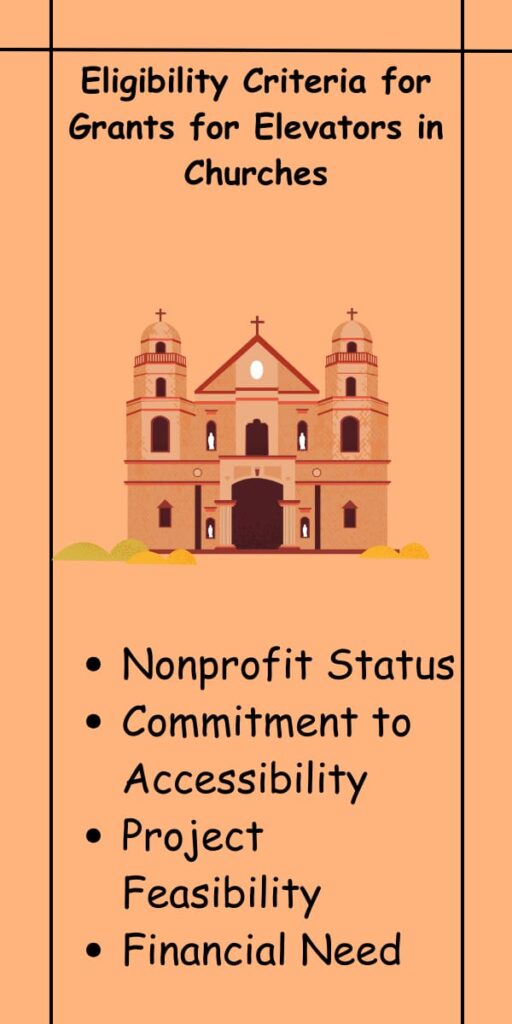
- Nonprofit Status: One of the primary eligibility requirements for grants for elevators in churches is the nonprofit status of the church. Grant providers typically require churches to be recognized as nonprofit organizations by the relevant government authorities. This status demonstrates the church’s commitment to serving the community and aligns with the philanthropic goals of many grant programs.
- Commitment to Accessibility: Grant providers prioritize churches that demonstrate a genuine commitment to enhancing accessibility within their facilities. Churches seeking grants for elevator projects must illustrate their dedication to making their buildings accessible to individuals with mobility impairments. This commitment may be evidenced through existing accessibility initiatives, such as the presence of ramps, accessible parking spaces, or other accommodations.
- Project Feasibility: Grant providers assess the feasibility and impact of proposed elevator projects when determining eligibility for funding. Churches must present a clear and well-defined plan for the installation of elevators, including details on the intended location, scope of work, timeline, and expected outcomes. Demonstrating the feasibility of the project enhances the church’s chances of securing grant funding.
- Financial Need: Grant providers may consider the financial need of the church when evaluating grant applications. Churches are often required to demonstrate their financial need for assistance with elevator installation costs. This may involve providing financial statements, budgets, or other documentation that illustrate the church’s financial capacity and the inadequacy of existing resources to fund the project independently.
By meeting these eligibility criteria, churches can position themselves as strong candidates for grants for elevators, increasing their likelihood of securing funding to improve accessibility within their facilities.
Document Requirements for Grants for Elevators in Churches
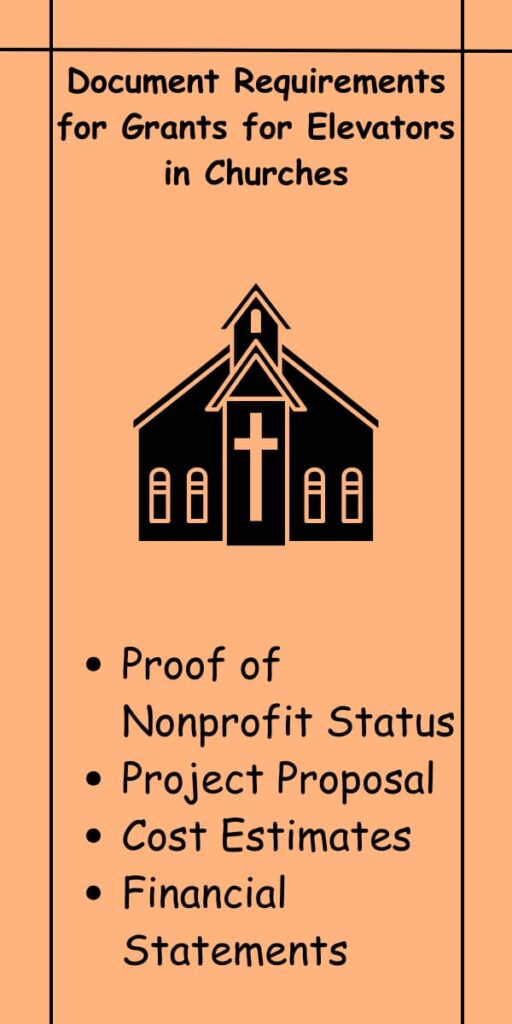
- Proof of Nonprofit Status: Churches seeking grants for elevators must provide documentation verifying their nonprofit status. This typically includes copies of official documents such as tax-exempt certificates, articles of incorporation, or letters of determination from the Internal Revenue Service (IRS) confirming the church’s nonprofit status.
- Project Proposal: A comprehensive project proposal outlining the need for an elevator and the intended use of grant funds is a critical document required for grant applications. The proposal should provide detailed information about the current accessibility challenges faced by the church, the proposed location and specifications of the elevator, the expected benefits to the congregation, and the estimated project costs.
- Cost Estimates: Churches are often required to submit detailed cost estimates for the elevator installation project as part of the grant application process. These estimates should itemize the expenses associated with the project, including equipment costs, construction materials, labor, permits, and any additional expenses. Accurate cost estimates help grant providers assess the financial feasibility of the project and allocate funds accordingly.
- Financial Statements: To demonstrate financial need, churches may need to provide financial statements or budgets as part of the grant application. These documents should provide an overview of the church’s financial standing, including income, expenses, assets, and liabilities. Financial statements help grant providers evaluate the church’s financial capacity and assess the need for grant assistance.
By compiling and submitting these required documents, churches can support their grant applications and provide the necessary information for grant providers to evaluate their eligibility and financial need.
Application Process for Grants for Elevators in Churches

- Research Grant Opportunities: The first step in the application process for grants for elevators in churches is to research available grant opportunities. Identify government agencies, nonprofit organizations, foundations, and religious institutions that offer grants specifically for elevator projects or accessibility enhancements in churches.
- Review Eligibility Criteria: Carefully review the eligibility criteria outlined by each grant provider to determine if the church meets the requirements for funding. Pay attention to criteria such as nonprofit status, commitment to accessibility, and project feasibility to ensure alignment with the grant program’s objectives.
- Prepare Required Documents: Gather all required documents, including proof of nonprofit status, project proposals, cost estimates, and financial statements, as specified by the grant provider. Ensure that the documents are accurate, complete, and organized according to the application guidelines.
- Complete the Application Form: Fill out the grant application form accurately and thoroughly, providing detailed information about the church’s need for an elevator, the proposed project plan, and the intended use of grant funds. Follow any specific formatting or submission instructions provided by the grant provider to ensure compliance.
- Submit the Application: Once the application is complete, submit it by the specified deadline, ensuring that all required documents are included. Double-check the submission requirements to avoid any errors or omissions that could affect the application’s review.
- Follow-Up and Communication: Maintain open communication with the grant provider throughout the application process. Follow up as needed to inquire about the status of the application, provide additional information if requested, and address any questions or concerns raised by the grant provider.
By following these steps and actively engaging with the application process, churches can increase their chances of securing grants for elevators and advancing accessibility initiatives within their facilities.
Types of Grants Provided for Elevators in Churches
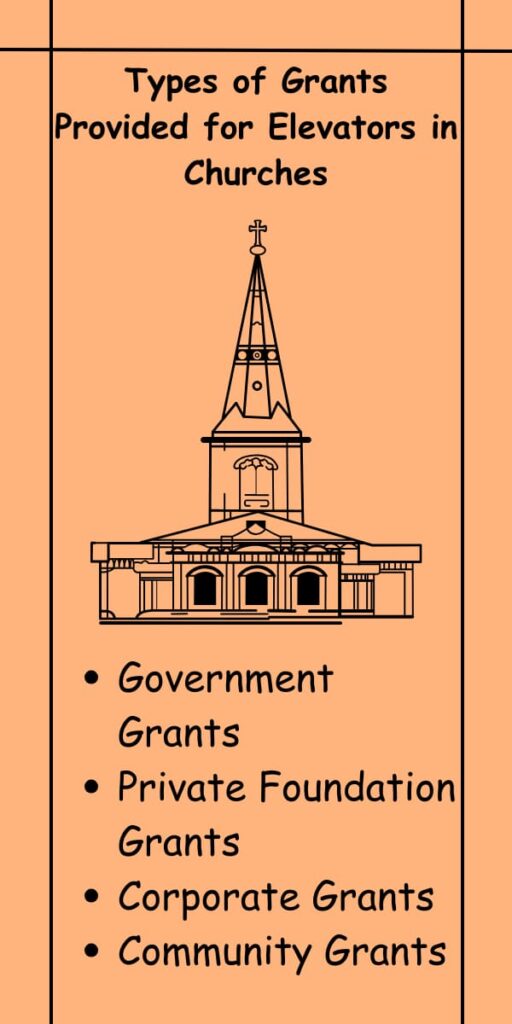
- Government Grants: Government agencies at the federal, state, and local levels offer various grants to support accessibility projects in churches, including elevator installations. These grants may be part of broader initiatives aimed at promoting inclusivity and compliance with accessibility standards. Government grants often have specific eligibility criteria and application processes that churches must adhere to when seeking funding for elevator projects.
- Private Foundation Grants: Private foundations and charitable organizations also provide grants to support elevator installations in churches. These grants may be offered by foundations with a focus on accessibility, disability rights, or community development. Private foundation grants may vary in terms of eligibility requirements, funding amounts, and application procedures. Churches can research and identify foundations that align with their mission and objectives regarding accessibility to seek funding for elevator projects.
- Corporate Grants: Corporations may offer grants or sponsorships to support community projects, including elevator installations in churches. Corporate grants for elevator projects may be part of corporate social responsibility initiatives aimed at improving accessibility and inclusivity in the communities where companies operate. Churches can explore partnerships with local corporations and businesses to identify potential funding opportunities for elevator projects and other accessibility enhancements.
- Community Grants: Local community organizations, civic groups, and religious institutions may provide grants to support elevator installations and accessibility initiatives in churches. These grants are often targeted towards projects that benefit the broader community and promote inclusivity. Churches can engage with local community organizations and religious groups to seek support for elevator projects through community grant programs. Community grants may offer flexibility in eligibility criteria and funding priorities, allowing churches to tailor their proposals to align with the specific needs of their congregation and community.
By exploring these various types of grants, churches can identify and pursue funding opportunities to support elevator installations and enhance accessibility within their facilities.
Each type of grant may have its own requirements and considerations, so churches should carefully research and assess their options to determine the best approach for securing funding for elevator projects.
List of Organizations that Offer Grants for Elevators in Churches
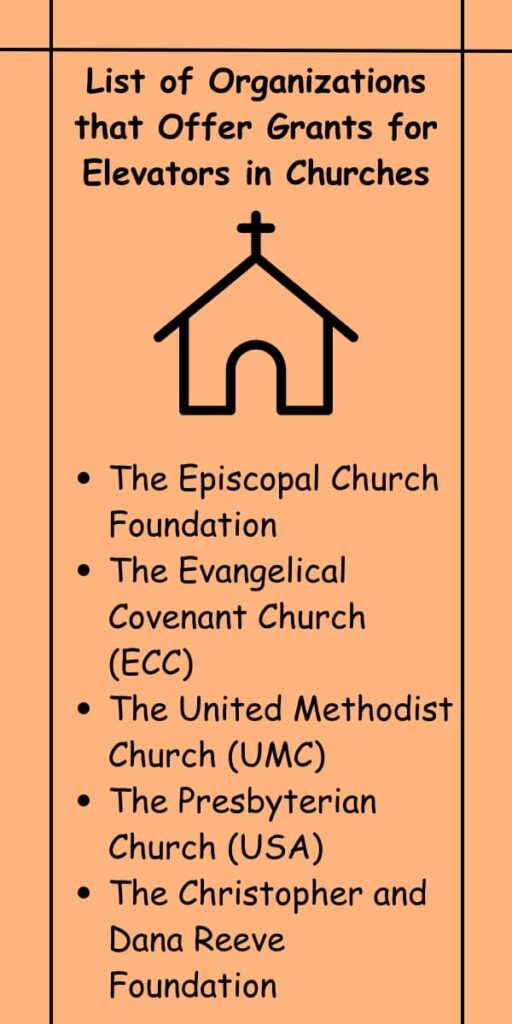
- The Episcopal Church Foundation: The Episcopal Church Foundation (ECF) is renowned for its commitment to fostering thriving, inclusive, and accessible church communities. Understanding the significance of accessibility, ECF extends grants to churches seeking to install elevators. These grants are part of ECF’s broader initiative to support congregations in creating welcoming spaces where all members can actively participate in worship and community activities. By offering financial assistance for elevator installations, ECF empowers churches to break down physical barriers and promote inclusivity among their members.
- The Evangelical Covenant Church (ECC): The Evangelical Covenant Church (ECC) prioritizes accessibility and inclusivity within its congregations. ECC’s grant programs reflect this commitment by providing funding opportunities for churches embarking on elevator installation projects. ECC’s grants aim to address accessibility challenges and ensure that all members of the congregation, including those with mobility impairments, can fully engage in church activities. By offering financial support for elevator installations, ECC empowers churches to create environments where everyone feels valued and included.
- The United Methodist Church (UMC): The United Methodist Church (UMC) is renowned for its dedication to social justice and inclusivity. As part of its mission, the UMC offers grants to support elevator installations in churches. These grants are instrumental in enabling UMC-affiliated congregations to overcome financial barriers and enhance accessibility within their facilities. By providing financial assistance for elevator projects, the UMC empowers churches to live out their commitment to welcoming all individuals, regardless of mobility challenges, into the community of faith.
- The Presbyterian Church (USA): The Presbyterian Church (USA) places a strong emphasis on accessibility and inclusivity in its congregations. Recognizing the importance of removing physical barriers, the Presbyterian Church (USA) offers grants to support elevator installations in churches. These grants enable Presbyterian congregations to undertake elevator projects that enhance accessibility and facilitate full participation in worship and community life. By providing financial support for elevator installations, the Presbyterian Church (USA) demonstrates its commitment to creating welcoming and inclusive environments for all members of the congregation.
- The Christopher and Dana Reeve Foundation: The Christopher and Dana Reeve Foundation is dedicated to improving the lives of individuals living with paralysis and mobility impairments. As part of its mission, the Reeve Foundation offers grants to support accessibility projects, including elevator installations in churches. These grants play a crucial role in enabling churches to remove physical barriers and create inclusive spaces where individuals with mobility challenges can fully participate in religious activities. By providing financial assistance for elevator projects, the Reeve Foundation helps churches promote accessibility and inclusivity in their communities.
Through these grant opportunities, churches can access the financial resources needed to install elevators and enhance accessibility within their facilities.
Each organization may have specific eligibility criteria, application processes, and funding priorities, underscoring the importance of thorough research and strategic planning when seeking grant support for elevator projects.
Conclusion
In conclusion, grants for elevators in churches serve as invaluable resources for promoting accessibility and inclusivity within religious communities.
By providing financial assistance for elevator installation projects, these grants empower churches to break down physical barriers and create welcoming environments where all members of the congregation can fully participate in religious activities.
Through diligent research, careful planning, and strategic engagement with grant providers, churches can successfully secure funding for elevator projects and embark on transformative initiatives to enhance accessibility within their facilities.
Furthermore, the availability of various types of grants—from government agencies, private foundations, and religious institutions—offers churches a range of options to explore and pursue funding opportunities that align with their specific needs and objectives.
By leveraging grant opportunities provided by organizations such as The Episcopal Church Foundation, The Evangelical Covenant Church (ECC), The United Methodist Church (UMC), The Presbyterian Church (USA), and The Christopher and Dana Reeve Foundation, churches can access the financial support needed to install elevators and improve accessibility for individuals with mobility impairments.
Ultimately, investing in elevator installations not only enhances accessibility within churches but also embodies the core values of inclusivity, hospitality, and community engagement.
By removing physical barriers and creating accessible spaces, churches demonstrate their commitment to welcoming all individuals, regardless of physical abilities, into the community of faith.
Through collaborative efforts and dedicated advocacy, churches can continue to promote accessibility and inclusivity, ensuring that everyone has equal opportunities to participate in worship, fellowship, and service within the church community.
[the_ad id=”39205″]
Frequently Asked Questions (FAQ):
What Is the Purpose of Grants for Elevators in Churches?
Grants for elevators in churches aim to provide financial assistance for the installation of elevators or accessibility enhancements. The goal is to remove physical barriers and create inclusive spaces where individuals with mobility impairments can fully participate in religious activities.
Who Offers Grants for Elevators in Churches?
Grants can be offered by various entities, including government agencies, nonprofit organizations, private foundations, religious institutions, and corporate sponsors. Different organizations may have specific eligibility criteria and application processes.
What Types of Projects Do These Grants Typically Cover?
Grants for elevators in churches may cover the costs associated with elevator installation, retrofitting existing structures to meet accessibility standards, and purchasing assistive technologies or equipment like stairlifts or platform lifts.
How Can a Church Determine Its Eligibility for These Grants?
Eligibility criteria vary, but common requirements include nonprofit status, a commitment to accessibility, a well-defined elevator project plan, and a demonstration of financial need. Churches should carefully review the criteria of each grant program.
What Documents Are Usually Required When Applying for Grants?
Required documents often include proof of nonprofit status, a detailed project proposal outlining the need for an elevator, itemized cost estimates, architectural plans, and financial statements demonstrating the church’s financial need.
How Can a Church Find Available Grants for Elevator Projects?
Churches can start by conducting thorough research to identify potential funding opportunities. Explore government websites, nonprofit organizations, religious institutions, and community resources. Networking with local advocacy groups may also provide valuable information.
What Steps Should a Church Follow When Applying for Grants?
The process typically involves thorough research, evaluating eligibility criteria, preparing required documents, completing the application form accurately, and submitting the application by the specified deadline. Maintaining open communication with the grant provider is also crucial.
How Can Community Support Enhance a Grant Application?
Engaging with the community, collaborating with local advocacy groups, and demonstrating broad community support can strengthen a grant application. This involvement emphasizes the project’s importance and its positive impact on the broader community.
Are There Different Types of Grants Available, and How Do They Differ?
Yes, grants can come from government agencies, private foundations, corporate sponsors, and community organizations. Each type of grant may have specific eligibility criteria, funding priorities, and application procedures.
What Are the Potential Benefits of Installing Elevators in Churches?
Installing elevators enhances accessibility, allowing all members of the congregation to participate fully in religious services and activities. It promotes inclusivity, demonstrates a commitment to community needs, and creates welcoming spaces for individuals with mobility challenges.




